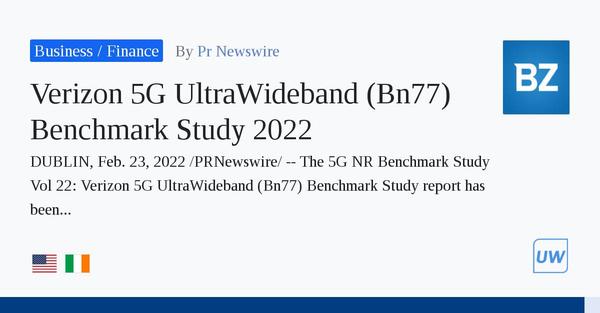
Verizon 5G UltraWideband (Bn77) Benchmark Study 2022 - ResearchAndMarkets.com
DUBLIN--(BUSINESS WIRE)--The "5G NR Benchmark Study Vol 22: Verizon 5G UltraWideband (Bn77) Benchmark Study" report has been added to ResearchAndMarkets.com's offering.
The Verizon 5G Ultra Wideband network is nothing like its predecessor, the Verizon 5G Nationwide network. Average downlink throughput was easily 15-20x higher than what was observed in October 2020 and the Bn77 coverage was substantially better than what was observed a little more than one year ago with Bn5. The Bn77 spectral efficiency was also much higher than observed with any of the operator's LTE bands.
The publisher logged at least 500 kilometers while drive testing with Bn77 present a good majority of the time - this time excluded the low double-digit percentage of the time when the smartphone was using mmWave. NR-DC is forthcoming in a few months but it isn't available today. They even ventured far west of Minneapolis while driving on remote gravel roads past horse farms while attached to the network.
Bn77 and LTE coverage was compared using all the traditional metrics. The publisher also dedicated much time comparing Bn77 and Bn41 (T-Mobile 2.5 GHz) performance and coverage, not to mention the effective coverage area of a cell site deployed in a rural area. While the laws of physics still exist, the results also indicate that while the areas with Bn41 modestly exceeded the areas with Bn77, the Bn77 uplink coverage and overall performance was superior to that of Bn41. No obvious Bn77 shortcomings were documented compared with the operator's LTE network coverage. Results indicate a one-to-one overlay and to the extent there were coverage gaps, there were attributed to existing LTE cell sites that haven't been upgraded with Bn77 radio assets. All testing was done outdoors, meaning in-building Bn77 coverage could be an issue.

Verizon has also deployed FDD-TDD carrier aggregation, which provides a critical performance advantage. The operator's 5G NR mmWave coverage has greatly expanded since last tested by the publisher - the total throughput with 400 MHz (4 carriers) was higher than what was observed with 800 MHz (8 carriers) when the network first launched.
The publisher has mixed opinions some other Bn77 performance attributes, based on analysis of the data. The "big bang for your buck" due to 4x4 MIMO and/or DL-256QAM wasn't evident in the data while vehicular speed seemed to have an impact on performance. If anything, the combination of understated results and coverage in rural areas where this amount of capacity doesn't seem necessary, and where good broadband options do not exist, bode well for FWA.
Highlights of the Report include the following:
Key Topics Covered:
For more information about this report visit https://www.researchandmarkets.com/r/3njq9n
About ResearchAndMarkets.com
ResearchAndMarkets.com is the world's leading source for international market research reports and market data. We provide you with the latest data on international and regional markets, key industries, the top companies, new products and the latest trends.
}})